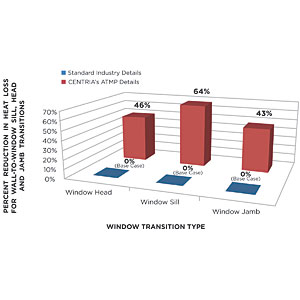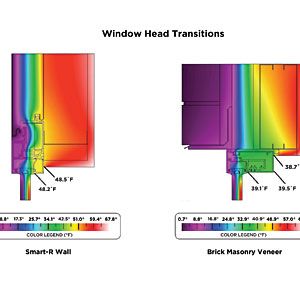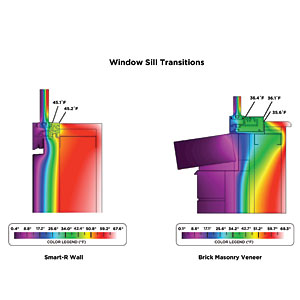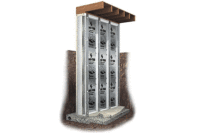Today’s evolving architectural industry calls for a new, smarter wall, offering not only the best in performance, sustainability, value and aesthetics, but advanced wall-to-window integration capabilities to meet the growing demands of sustainable construction. Integrated, insulated metal panel wall and aluminum window systems are specifically designed to work together to offer the highest level of performance on all counts.
Insulated metal panels have been on the marketplace for over 30 years. This exterior wall product is unique because it combines metal skins with foam insulation for optimal thermal, air, moisture and vapor barriers in a single panelized component, providing quick and easy installation for all climates. Insulated metal panels are commonly used on single- or multi-story buildings worldwide, including hospitals, arenas and stadiums, K-12 and higher education campuses, government and industrial facilities, and other construction markets.
Insulated metal panel systems with truly integrated components seamlessly assimilate unlike components like walls and windows while maintaining the integral thermal, air, vapor and moisture barriers—without relying on receptors, exposed sealants, or flashing. Integrated components can greatly enhance thermal performance, a vital indicator of a building’s overall energy efficiency.
“With the current green design culture shift, thermal performance has to be understood and determined very early in the process so that it can be considered a component in a comprehensive system,” architect John Keelan, AIA, noted.
As a Project Manager with Pittsburgh-based IKM Incorporated, Keelan served as designer and lead architect on the recently completed expansions of the Erie County Medical Center campus in Buffalo, N.Y. Facing Buffalo’s notoriously heavy winters, Keelan knows firsthand the value of energy efficient design principles.
THERMAL AND MOISTURE PERFORMANCE
One of the most effective ways to reduce heat loss is to optimize wall system interface features such as panel joints, extrusions and windows, locations that typically allow a greater percentage of heat flow or moisture intrusion.
“Heat loss commonly occurs in window transitions at the head, sill and jamb—areas that rely on complicated interface details that often do not properly connect the air, water, vapor or thermal barriers between opaque wall areas and window,” says Director of Architectural Wall Technology Keith Boyer, P.E., at CENTRIA. “Windows and walls that are not engineered to work together allow heat loss for any number of reasons, including minimal insulation or a lack of thermal break, leading to conductivity through trim or flashings.”
According to American Society of Heating, Refrigerating and Air-Conditioning Engineers, Inc. statistics, windows can account for up to 40 percent of a building’s enclosure (ASHRAE Standard 90.1). This often translates to hundreds of feet of window perimeter details—such as panel-to-window transitions at the head, sill and jamb—that are not optimized for thermal performance. Non-integrated wall and window systems may result in higher levels of heat loss, as well as increased risk of condensation, which not only impacts thermal performance but creates an environment for harmful mold or corrosion.
For this reason, it is vital to select a window system that offers integrated detailing at window openings, as well as expansive thermal breaks aligned with the panel insulation. Additional insulation in the head of a window frame also greatly improves thermal performance.
Non-integrated wall and window systems show a dramatic amount of heat transfer when compared to the leading integrated metal wall and window systems. In fact, an analysis utilizing THERM 6.3 Heat Transfer Analysis Software proved that integrated systems reduced window sill heat loss up to 64 percent compared to standard wall-to-window transitions in wintertime conditions (Figure 1).
 Of course, materials also play a vital role in the selection of an integrated wall and window system. The overall thermal performance of a wall is affected by the performance of the components that make up the wall, with special focus on transition details like windows—where many traditional brick and masonry veneers and precast concrete panels fail.
Of course, materials also play a vital role in the selection of an integrated wall and window system. The overall thermal performance of a wall is affected by the performance of the components that make up the wall, with special focus on transition details like windows—where many traditional brick and masonry veneers and precast concrete panels fail.
It is important to utilize insulation outside of the building cavity for optimal thermal performance. Traditional brick and precast insulation may typically make use of 6-inch fiberglass BAT or 2-inch board stock for an expected combined R-value of 19. On the other hand, leading 3 inches thick, insulated metal panels offer an R-Value of up to 22, thanks in part to factory foamed-in-place cores that minimize insulation gaps and tactfully designed panel joinery with thermal breaks between panel face and liner. These leading panel systems also offer the added benefit of advanced integration capabilities with windows, louvers, translucent panels or perimeter extrusions.
Often when an air barrier fails within a wall system, it is due to the lack of continuity at transition details. Improperly detailed or installed air barriers between separate wall and window components are often part of the demise of a building’s overall performance. Integrated, insulated metal panel wall and window systems allow for efficient continuity of the air barrier through the use of consistent detailing and like materials.
SUSTAINABILITY
Sustainability is a key issue in green construction. By eliminating the use of receptors or exposed sealants, integrated metal panel wall and window systems with dry-seal joinery minimize the amount of materials used. Integrated metal panel wall and window systems are also engineered to fit the project, reducing overall material use and jobsite waste. In addition, integrated components that are fine tuned for optimal thermal performance improve energy efficiency and reduce HVAC costs and overall environmental impact, while making use of natural lighting.
Leading steel-clad insulated metal panel systems use up to 6 percent pre-consumer and 23 percent post-consumer recycled content. Moreover, these systems feature 100 percent recyclable sheet metal and HCFC-free foam insulation.
VALUE
Integrated, insulated metal panel wall and window systems also reduce installation time—particularly when using products manufactured by a single source. Shop- assembled windows work in tandem with wall panels that are custom fabricated to length to greatly reduce labor costs, while providing a weathertight building exterior at a fraction of the time of non-integrated systems. Time savings can increase exponentially as interior trade installation moves forward ahead of schedule.
assembled windows work in tandem with wall panels that are custom fabricated to length to greatly reduce labor costs, while providing a weathertight building exterior at a fraction of the time of non-integrated systems. Time savings can increase exponentially as interior trade installation moves forward ahead of schedule.
“The integration of window and wall allows for simplified detailing,” Keelan says. “This was a great advantage to a project with a tight timeline. It allows the contractor to move inside the building much faster by comparison.”
Integrated building envelope systems from a single manufacturer offer an unmatched level of coordination between architect, installer, dealer and contractor.
“It is wonderful to have a single source to turn to for advice on all aspects of shell design,” Keelan says. “It is equally wonderful to receive submittals with the window manufacturer and the cladding manufacturer fully integrated and coordinated. This coordination benefits everyone down the line—most importantly the owner.”
AESTHETICS
Choosing an integrated wall and window system offers advanced energy efficiency and performance without sacrificing aesthetics. Building designers can employ integrated windows to add complementary sightlines. Additionally, integrated wall and window components produced by the same manufacturer are often available in a wide variety of substrates, colors, profiles and surface textures for a virtually unlimited aesthetic palette.
“Aesthetically, with an integrated system the entire envelope appears more consistent in detailing and finish,” Keelan added. W&C










